If you’re interested in Fujifilm’s X series of cameras, you’ve probably discovered that there are several different model lines to choose from. It can be hard to determine exactly what’s different between each model, and it’s important to pick the camera model that fits your needs best. In this article, we’ll cover each of Fuji’s current X-mount cameras and explain the differences between each.
Why Fuji?
We like Fuji cameras for a few key reasons. First, every X-mount camera uses an APS-C sensor, which is smaller than a full-frame sensor and means that the camera bodies and lenses can be smaller and lighter than their full-frame equivalents. Unlike other brands whose only APS-C cameras are their lower-end models, Fuji offers high-end cameras with this smaller sensor. We like the smaller size for portability, and feel that modern APS-C cameras are competitive with full-frame.
Fuji also has a unique camera design philosophy. Many of their cameras feature dial-based controls for common settings, similar to analog cameras of old. They also emphasize their built-in film simulations, which are predefined “looks” for images that affect the color balance, dynamic range, grain, and overall appearance of your photos. While you can easily shoot in a standard profile (or RAW) and edit the photos yourself, these film simulations give you the ability to get great, unique photos straight out of the camera.
It feels to us as though Fuji focuses on the experience of using their cameras, and wants photography and videography to be a fun and engaging experience, where you’re making intentional decisions about the images you want to capture. And with the small size of the cameras, you can take it with you everywhere.
Fuji also makes medium-format cameras, which is a much larger sensor size than even full-frame cameras. These cameras are in a different price class and are targeted at a different market, so we won’t be covering them here. For this article, we will be focusing on the Fujifilm X series of cameras.
Fuji X Camera Lines
There are several models in the Fujifilm X system, and many appear to be similar at a glance. We’ve organized them here by size and purpose.
Note: Fuji Resource may receive a commission for items you purchase from this page, at no additional cost to you. For more information, please see our affiliate link policy.
We’ve categorized the cameras as follows:
Entry Level Cameras
These cameras are the most affordable options in the Fuji X series, making them a great way to get into Fuji cameras. However, they’re also compelling for experienced photographers due to their small size. Many of these cameras still use the same sensor as Fuji’s higher-end cameras, giving you the same image quality from the higher-end modules at a much lower price point.
Fuji X-T200
The X-T200 is the most affordable X series camera that still provides the same analog-inspired experience of using a Fuji camera. It features a 24MP sensor and has both an electronic viewfinder (EVF) as well as an LCD screen that can flip completely around for taking photos and videos of yourself. It’s a small and compact camera, but still uses the standard X mount, allowing you to use any X-mount lens with the camera.
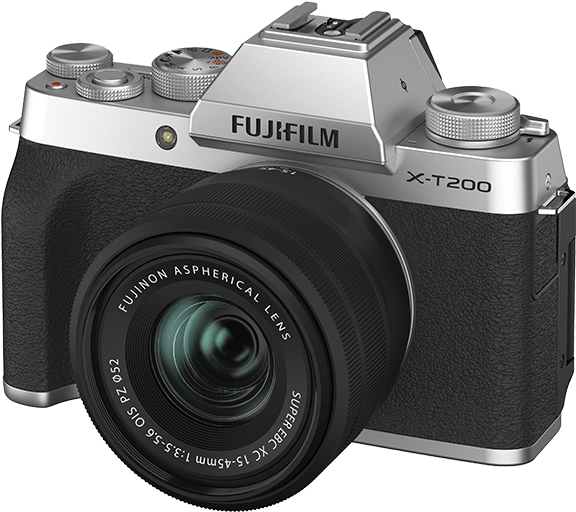
The X-T200 can also record 4K video, although it’s limited to 30 frames per second and can only record up to 15-minute clips. The camera features in-body image stabilization (IBIS), making it easier to get stable video or to use a long focal length lens for photos.
Overall, the X-T200 is a solid camera that is competitive among other cameras at its price point. It lacks some of the features of the higher-end Fuji models, but uses the same X-mount lenses and includes many of the qualities that we find appealing in Fuji cameras.
Key Specs:
- Standard body with electronic viewfinder and full-flip LCD screen
- 24MP sensor
- 4K video up to 30 fps, 15 minute record limit
- IBIS
You can see the Fuji X-T200 here: B&H Photo
Mid-Range Cameras
These cameras fit into the middle of Fuji’s lineup, with a price that sits between their entry-level models but below the highest-end options. The cameras in this category tend to be evenly balanced between photo and video capabilities, making them an appropriate choice if you want a camera that can do both.
Fuji X-E4
The X-E4 is Fuji’s most affordable rangefinder-style camera. Although the term “rangefinder” doesn’t describe anything about the operation of the camera the way it did for film cameras, rangefinder-style digital cameras typically feature a compact body which does not include the substantial right-hand grip found on standard cameras. The viewfinder is also typically located on the upper left corner of the back of the camera, rather than in the center.
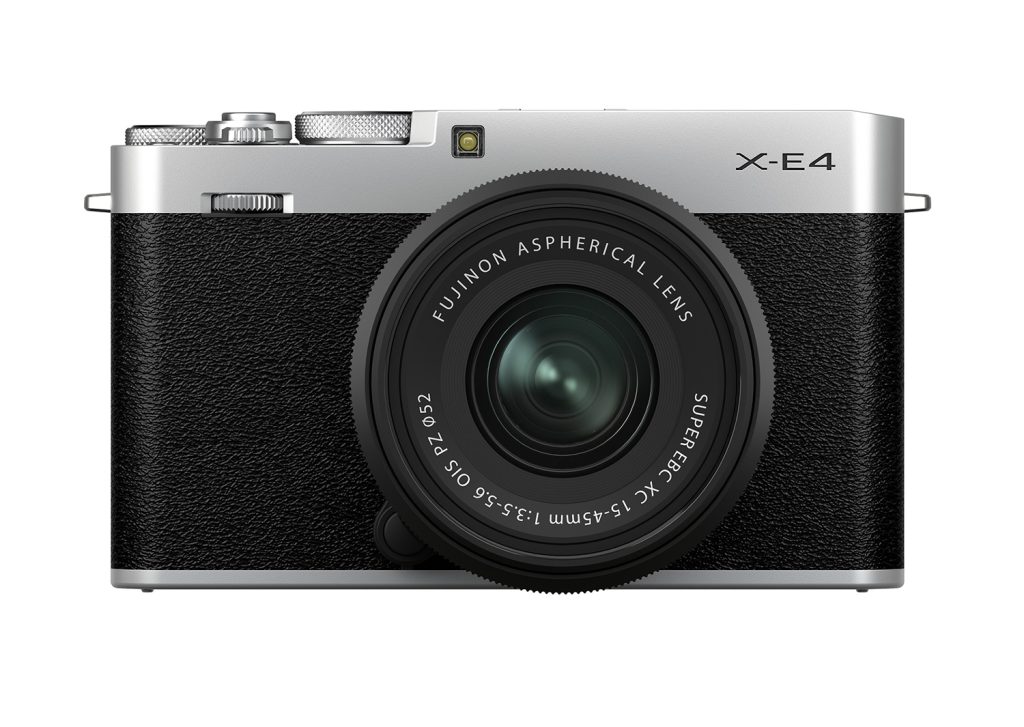
The X-E4 includes a physical dial for shutter speed, and Fuji lenses typically include an aperture dial on the lens, allowing you to configure these settings easily without looking at the screen. It has a standard electronic viewfinder, as well as an LCD screen that can flip 180 degrees upward. This is perhaps the most useful style of flip LCD for a photo-centric camera–it allows you to see the screen from the front when needed, but when you’re behind the camera, you can easily tilt the screen upward for low-angle shooting.
Despite its small size, the X-E4 uses the same 26MP X-Trans 4 sensor found on higher-end models such as the X-T4, X-Pro3, and X100V. This means that the image quality of the X-E4 will be identical to those cameras, all of which are much more expensive. The autofocus system also matches the one used in the X-T4 and X-Pro3, giving you excellent performance in that area as well.
For video shooters, the X-E4 is quite capable, with one flaw. It can shoot 4K video at 30 frames per second, or 1080p at 240 frames per second. If recording externally via the micro HDMI port on the side, it can output 10-bit 4:2:2 video. Unfortunately, the X-E4 doesn’t include IBIS, so you’ll want to use a stabilized lens for most video use.
Overall, the X-E4 is a compelling option as a travel camera or first entry into the Fuji X system. It offers the same image quality as some of Fuji’s highest-end X mount cameras and includes decent video features, although IBIS would have been a nice addition. If you’re looking for a compact, capable camera and mostly take photos, the X-E4 is worth a look.
Key Specs:
- Rangefinder body with electronic viewfinder and 180-degree flip-up LCD screen
- Physical shutter speed dial
- 26MP X-Trans 4 sensor
- 4K video at 30fps, 1080p at 240fps
You can view the Fuji X-E4 here: Adorama | B&H Photo | Amazon
Fuji X-T30 II
The XT-30 II features extensive physical controls and the same 26MP X-Trans 4 sensor found on Fuji’s more expensive cameras. It’s partway between a rangefinder and standard body camera: although it doesn’t have a prominent hand grip, the electronic viewfinder is positioned in the center rather than on the left side. The LCD screen on the X-T30 II is a bit of a disappointment in that it’s a tilt screen, but cannot flip a full 180 degrees. This setup is ideal for standing behind the camera, but prevents you from seeing the screen if you’re taking a photo or video of yourself.

Since it uses the X-Trans 4 sensor, the image quality of the X-T30 II matches that of Fuji’s higher-end cameras. On the video side, it can shoot 4K video at 30 frames per second or 1080p video at 240 frames per second. You also have the option to record in F-Log, which is a flatter color profile that is ideal for professional video workflows and matching footage from other cameras. Unfortunately, the XT-30 II doesn’t include IBIS.
The most attractive features of the X-T30 II are its small size and extensive physical controls. With physical dials for shutter speed, exposure compensation, drive mode, and aperture (if you’re using a Fuji lens), you can largely operate the camera without needing to use buttons or the touchscreen.
Key Specs:
- Standard body that is very compact, with a tilt LCD that cannot flip a full 180 degrees
- Physical shutter speed, exposure compensation, and drive mode dials
- 26MP X-Trans 4 sensor
- 4K video up to 30fps, 1080p video up to 240fps
You can view the Fuji X-T30 II here: Adorama | B&H Photo | Amazon
Fuji X-S10
The X-S10 is an interesting departure from Fuji’s typical camera design patterns. While it has the same retro-inspired body design and includes the same film simulations found on Fuji’s other cameras, it forgoes the dial-based camera controls in favor of the “PSAM” dial found on most other digital cameras. The PSAM (Program, Shutter Priority, Aperture Priority, Manual) dial allows you to pick one of 4 modes which automatically select some or all of the key camera settings, making it faster and easier to capture properly-exposed photos and video.

With its full-flip LCD, standard body style, and PSAM dial, the X-S10 looks like a standard digital camera from the outside. But it’s still a Fuji camera at heart, with the 26MP X-Trans 4 sensor and 11 film simulations. Similar to the X-T30 II and X-E4, the X-S10 can record 4K video at 30fps and 1080p video at 240fps, and supports 10-bit 4:2:2 recording through its micro HDMI port. But unlike those cameras, the X-S10 also includes IBIS, making it much easier to record stable video on the move.
The X-S10 is definitely a different style of camera than much of Fuji’s lineup, and if the physical dials on Fuji’s cameras are important to you, this isn’t the right choice. However, if you’re used to using cameras from other brands but want to take advantage of Fuji’s film simulations and lens ecosystem, the X-S10 may be exactly what you’re looking for.
Key Specs:
- Standard body with a PSAM dial instead of Fuji-style dial controls
- Full-flip LCD and electronic viewfinder
- 26MP X-Trans 4 sensor
- 4K video at 30fps, 1080p video at 240fps
- IBIS
You can view the Fuji X-S10 here: Adorama | B&H Photo | Amazon
High-End Cameras
The cameras in this category are more expensive than the rest of the cameras in the Fujifilm X series, but they provide features that can make them worth the added cost. If video capability is important to you, you will probably want to consider a camera in this category.
Fuji X-T4
The X-T4 is a mid to high end hybrid camera that provides an even balance of photo and video features. It has the most physical control options of any Fuji X camera, with dials for shutter speed, ISO, exposure compensation, and drive mode. New to the X-T4 is a full flip LCD screen, which provides the most flexibility for shooting at different angles (although for working behind the camera, we prefer tilt-only screens).
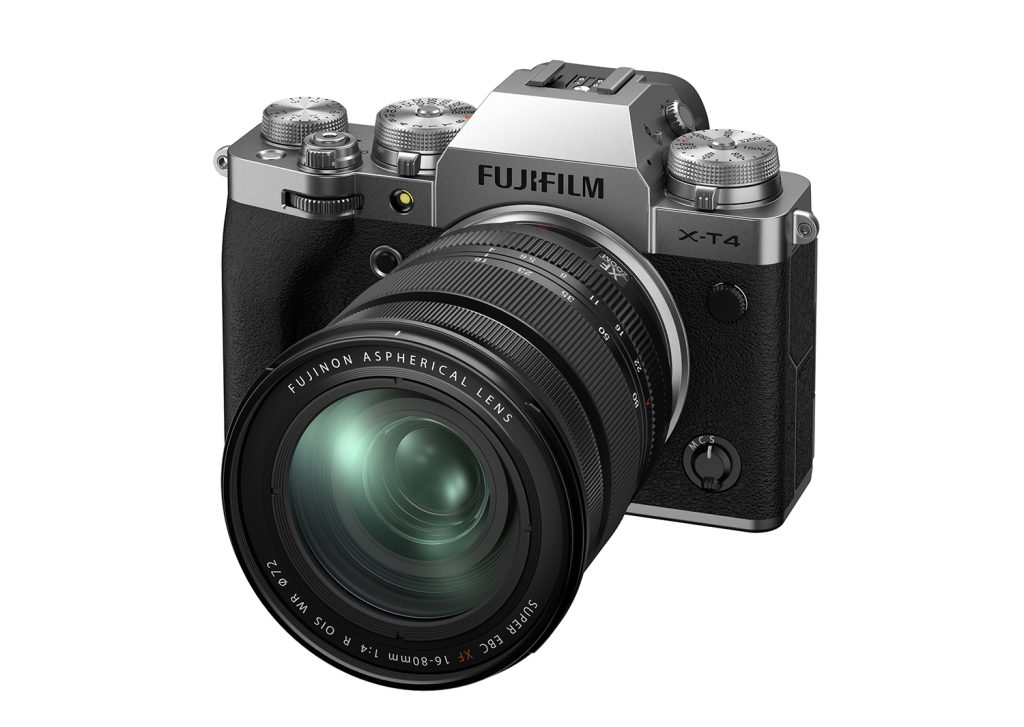
With the same 26MP X-Trans 4 sensor found in several of Fuji’s other cameras, the X-T4 is plenty capable for both photos and video. It can shoot 4K video at 60 frames per second and 1080p at 240 frames per second, and supports 10-bit 4:2:2 recording via its micro HDMI port. The camera also includes IBIS, which is a welcome feature for video shooters.
If you like having physical controls for all of the key camera settings and are looking for a high-end camera that is equally suited to both photo and video, the X-T4 is an excellent choice.
Key Specs:
- Standard body with a large number of physical dials
- Full-flip LCD screen and electronic viewfinder
- 26MP X-Trans 4 sensor
- 4K video at 60 fps, and 1080p video at 240 fps
- IBIS
You can view the Fuji X-T4 here: Adorama | B&H Photo | Amazon
Fuji X-T5
The X-T5 is a photo-focused hybrid camera that stands in Fuji’s lineup as its highest-end X-mount photo camera with the traditional Fuji dials for shutter speed, ISO, exposure compensation, and drive mode. It’s smaller than the X-T3 and X-T4, and returns to the tilt-only screen of the X-T3 and previous–a change we prefer for photo shooting.
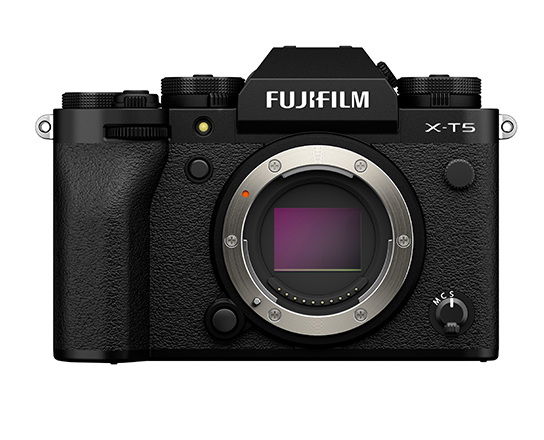
Despite its smaller size, the X-T5 includes the same 40MP X-Trans 5 sensor introduced with the X-H2, giving it an impressively high resolution that outclasses any other APS-C camera of its size. While its photo resolution matches the X-H2, there are a few downsides compared to that camera. The X-T5 isn’t capable of shooting 8K video, and has a significantly smaller RAW image buffer–it can only hold 37 RAW frames in its buffer during continuous shooting, compared to the 1000 frames the X-H2 can manage.
For photo shooters who prefer an arrangement of manual dial controls over the PSAM dial, the X-T5 is Fuji’s top-end X-mount option. It offers a strong set of features in a camera that is clearly designed for photographers. At the same time, it still includes impressive video capabilities and would have no trouble for general video use or as a B-cam for a more video-oriented Fuji camera.
Key specs:
- Standard body with a large number of physical dials
- Tilt LCD screen and electronic viewfinder
- 40MP X-Trans 5 sensor
- 6.2K video at 30 fps, 4K at 60 fps, and 1080p at 240 fps
- IBIS
You can view the Fuji X-T5 here: Adorama | B&H Photo
Fuji X-H2
The X-H2 is one of the highest-end Fuji cameras you can buy, with the highest resolution sensor ever found in an APS-C camera. Unlike many of Fuji’s other cameras, it features a PSAM mode dial rather than individual controls for shutter speed and ISO, making the controls more similar to cameras from other brands. It’s also one of the largest X series cameras, with a substantial hand grip and a large body. It includes an electronic viewfinder and a full-flip LCD screen.
The X-H2 uses a new 40MP X-Trans 5 sensor, giving it the highest resolution of any Fuji X camera. For photo use, the extra resolution in this camera makes it a compelling choice. There are a few small downsides to the higher-resolution sensor as compared to the stacked version found on the X-H2S: its autofocus performance is slightly slower than that of the X-H2S, and it exhibits worse rolling shutter performance.
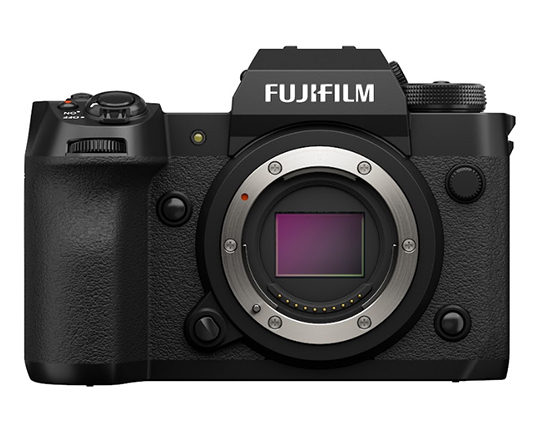
On the video side, this camera provides a number of noteworthy features, such as 8K recording at 30 frames per second, 4K at 60 frames per second, and 1080p at 240 frames per second. It can record 10-bit 4:2:2 video internally with ProRes (although not in 8K mode) and includes the new F-Log 2 color profile. The camera also includes IBIS.
The X-H2 provides class-leading image resolution and is an ideal choice for users who want a photo-focused camera that also has very competitive video capabilities. It’s likely the best choice for a high-end camera if you are more heavily into photos than video, although for action photography, the X-H2S below would be a better choice due to its faster burst rate and autofocus speed.
Key Specs:
- Standard body with PSAM dial
- Full-flip LCD screen and electronic viewfinder
- 40MP X-Trans 5 sensor
- 8K video at 30 fps, 4K at 60 fps, and 1080p at 240 fps, ProRes 10-bit 4:2:2 internal recording
- IBIS
You can view the Fuji X-H2 here: Adorama | B&H Photo | Amazon
Fuji X-H2S
The X-H2S is Fuji’s most capable camera for video shooters, although it still provides excellent photo features. Unlike many of Fuji’s other cameras, it features a PSAM mode dial rather than individual controls for shutter speed and ISO, making the controls more similar to cameras from other brands. It’s also one of the largest X series cameras, with a substantial hand grip and a large body. It includes an electronic viewfinder and a full-flip LCD screen.
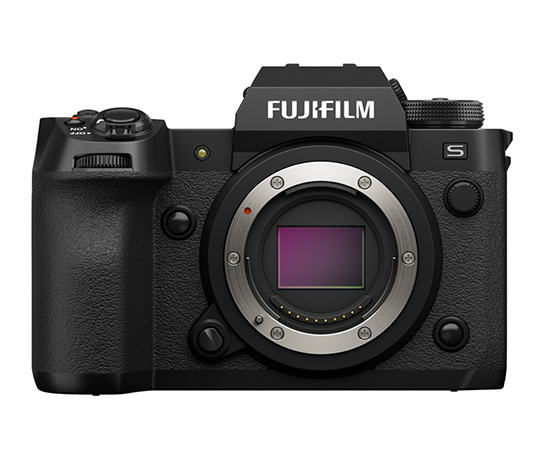
This camera includes one of Fuji’s newest sensors, the stacked back-side illuminated 26MP X-Trans 5. This gives the X-H2S notably better autofocus and low-light performance compared to cameras with the older sensors, and makes it an excellent choice for sports photography and general use. The camera can shoot photos at up to 40 frames per second.
On the video side, the X-H2S provides unmatched capability among Fuji’s lineup. It can shoot 4K video at up to 120 frames per second, and also supports a 6.2K open-gate mode at 30 frames per second. It can record in ProRes internally, and supports a new F-Log 2 color profile with up to 14 stops of dynamic range. It also includes IBIS. For serious video shooters, this is the camera to get.
Although it is a slight departure from Fuji’s standard design with its PSAM dial, the X-H2S should definitely be in consideration if you’re looking for a high-end Fuji camera. In particular, if you’re interested in shooting video or doing sports photography, this is most likely the camera you should get.
Key Specs:
- Standard body with PSAM dial
- Full-flip LCD screen and electronic viewfinder
- 26MP X-Trans 5 sensor
- 4K video at 120 fps, 1080p video at 240fps, ProRes 10-bit 4:2:2 internal recording
- IBIS
You can view the Fuji X-H2S here: Adorama | B&H Photo | Amazon
Specialty Cameras
The cameras in this category are distinctive from the rest of Fuji’s X series lineup in a few major ways. They aren’t for everyone, but they might be exactly what you’re looking for.
Fuji X-Pro3
The X-Pro3 leans heavily into the Fuji ideal of digital cameras that act similar to film cameras. The rangefinder-style body features an optical viewfinder (unusual on a modern mirrorless camera) and has an LCD screen that is designed to be closed during normal use. When the LCD is closed, a small display on the back shows your shutter speed, aperture, and other settings, but if you want to review shots or use the LCD to take photos, you’ll have to flip the screen outward to see it.
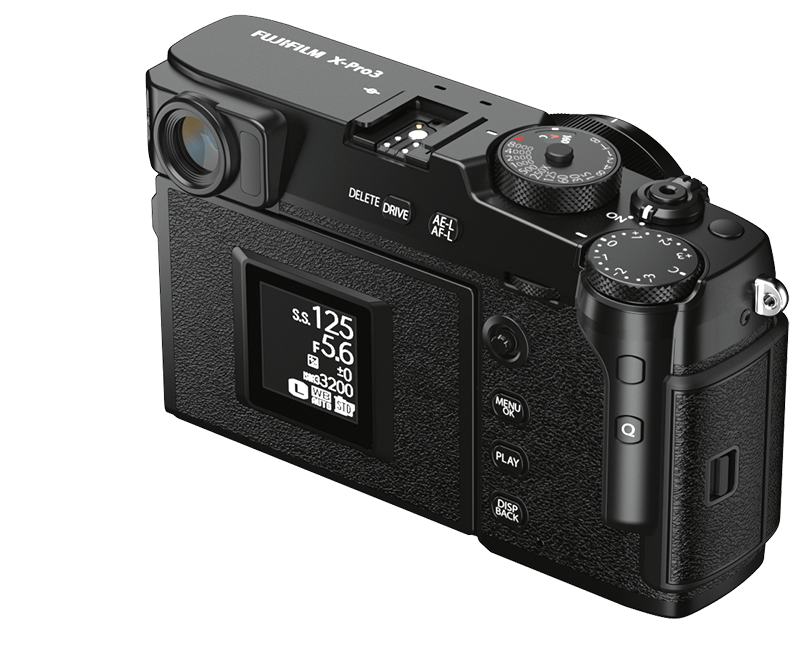
Using the X-Pro3 will feel different than using any other Fuji camera, and different from almost any other digital camera you can buy today. It’s clearly designed for you to use the viewfinder only, and to not review every shot as soon as you take it. We would classify this as a “purist” camera, and one that would be well-suited for street photography, travel, and similar uses.
The X-Pro3’s image quality will match most other camera’s in Fuji’s lineup, with the same 26MP X-Trans 4 sensor and a similar set of film simulations as those found on the other cameras. It can shoot 4K video at up to 30 frames per second, but this probably isn’t the camera for you if video capability is important to you.
The X-Pro3 is certainly a unique camera, and probably one that you know if you’re interested in or not. It’s an interesting approach to making a digital camera feel like a film camera, and while it may go a little too far in that direction, it’s a one-of-a-kind model.
Key Specs:
- Rangefinder body with physical dials for shutter speed and exposure compensation
- Unique normally-hidden LCD screen with a small rear display for camera settings
- Optical and electronic hybrid viewfinder
- 26MP X-Trans 4 sensor
You can view the Fuji X-Pro3 here: Adorama | B&H Photo | Amazon
Fuji X100V
The X100V is unique in Fuji’s lineup as their only premium offering with a built-in lens. This camera has a compact rangefinder-style body with an integrated 23mm f/2 lens, making it extremely compact. It includes an optical viewfinder as well as a tilt LCD screen, and has physical dials for shutter speed and exposure compensation.

This camera includes the same 26MP X-Trans 4 sensor found on many of Fuji’s other cameras, giving it the same excellent image quality and photo capabilities. It has comparable video features to other Fuji cameras, with 4K up to 30 frames per second and 1080p up to 120 frames per second. It doesn’t include IBIS, which is a downside for video shooting.
The obvious downside to the X100V is the fixed focal length lens, which limits its flexibility. However, the 23mm f/2 lens is essentially a 35mm equivalent length, which was always a very popular focal length for film cameras. If you’re looking for a travel or casual-use camera and want excellent image quality without having to mess with swapping lenses, the X100V is worth a look.
Key Specs:
- Rangefinder body with fixed focal length 23mm f/2 lens
- Physical dials for shutter speed and exposure compensation
- Optical viewfinder and tilt LCD screen
- 26MP X-Trans 4 sensor
- 4K video up to 30 frames per second, 1080p video up to 120 frames per second
You can view the Fuji X100V here: Adorama | B&H Photo | Amazon
Which Fuji Camera is Best For You?
As you can see, Fuji has a wide variety of current models, giving you the ability to choose which body style, controls, feature set, and price suits your needs best. What’s so interesting about the lineup is that almost all of the cameras use the same sensor, meaning that many of these cameras will have almost exactly the same image quality. This means that if you want a compact camera for travel, you don’t necessarily have to compromise on image quality compared to the larger, more expensive models.
Choosing a camera is a big decision with a lot of variables, but we recommend starting by considering what your budget is (don’t forget that you may need to buy a lens!) and whether you want a compact rangefinder-style camera or a more standard camera with a larger hand grip. Those two factors will likely narrow down your choices to only a few models, and you can compare the features from there to decide which one fits your needs best.